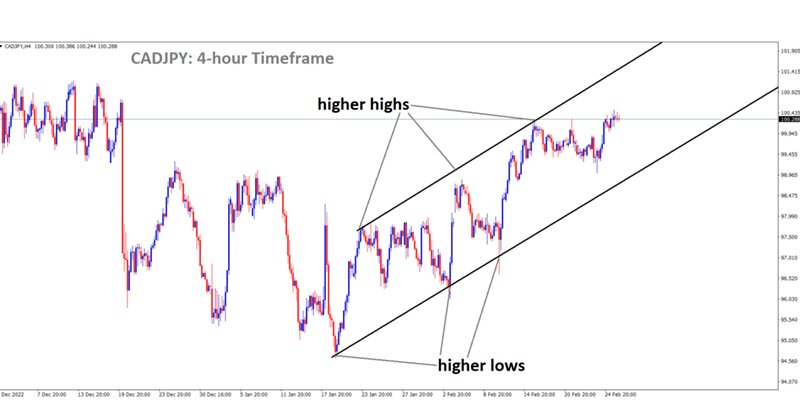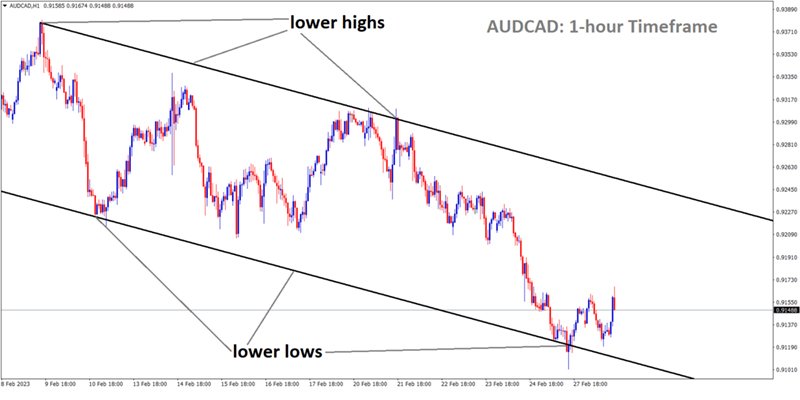Upcoming Canada GDP Data Will Depend on CPI Data

USDCAD is moving in an Ascending channel and the market has rebounded from the higher low area of the channel.
Canada is soon to release their GDP data and analysts are predicting that it will be the same as previous numbers. BOC Governor believes that the CPI data is a large player in deciding the GDP of the country. Furthermore, lower oil prices are not doing much good for the loony.
Canada CPI Data
In January, the Consumer Price Index (CPI) showed a year-over-year increase of 5.9%, after a month in which it had shown a year-over-year increase of 6.3%. The Consumer Price Index (CPI) is an industry-standard measure of the price of a sample basket of goods and services purchased by consumers. The primary indicator of consumer price inflation is the year-over-year percentage change in the Consumer Price Index (CPI) between the current month (January 2023) and a base month or the same calendar month from the prior year (January 2022).

EURCAD is moving in the Descending triangle pattern and the market has rebounded from the horizontal support area of the pattern.
The month-over-month increase in the overall CPI of all products was driven mostly by the price of gasoline, which increased by 4.7% in January. In January, the price of gasoline increased by 2.9% compared to the same time last year, marking a minor slowdown from the 3.0% increase that was seen in December. The year-over-year increase in meat costs of 7.3% was a contributing factor to the month-over-month increase in grocery prices that was the most it had been since June 2004.

This was the greatest month-over-month increase. The price of fresh or frozen chicken was a significant contributor to the gain, as it increased by 9.0% in January compared with December. This represents the highest monthly increase in chicken prices since September 1986.
Foreign Workers in Canada
Canada has set a goal to accept around 1.45 million immigrants over the course of the next three years, with the expectation that 60% of them will be under economic class programs. It is anticipated that the recent influx of newcomers will have a number of beneficial implications on the economy of Canada. For instance, the likelihood of employment for newly arrived immigrants is currently higher than it is for their contemporaries who were born in Canada.

GBPCAD is moving in the Descending triangle pattern and the market has rebounded from the horizontal support area of the pattern.
This is a relatively new phenomena that may be attributed to the convergence of two significant trends: Beginning in 2016, there was a discernible rise in the percentage of newly arrived immigrants who were employed, while the percentage of native-born Canadians who were employed gradually decreased. There is a stronger connection between recent immigrants and the work force. Many of them already have employment when they arrive in the nation, and they were granted admission due to aspects related to their human capital that make it possible for them to successfully contribute to the labor.

Because of this, it is anticipated that immigration will result in an increase in Canada’s GDP per capita due to the anticipated rise in labor input brought about by immigration. The gross domestic product (GDP) of a nation is the sum total monetary worth of all the finished products and services that are produced within its boundaries. An increase in GDP is often indicative of a robust economy, and it may result in additional advantages such as an expansion of employment opportunities and a rise in average salary levels. It is anticipated that the entrance of newcomers would further assist in bolstering the supply side economy, hence reducing inflationary pressures on the economy of Canada.
Canada Housing Crisis
Canada, along with Iceland, the Netherlands, Sweden, and Denmark, is among the five most vulnerable countries, and there is a 7% chance that this will lead to a banking crisis within the next year, and there is an 18% to 20% chance that this will lead to a banking crisis within the next three to five years. These marketplaces are all characterized by the same two characteristics.

CADJPY is moving in an Ascending channel and the market has reached the higher high area of the channel.
A housing market that overheated during the epidemic when borrowing rates were low and is now seeing a significant decrease in house values and credit now that interest rates have soared, in the case of Canada by as much as 4.25 percentage points. It is undoubtedly debatable as to whether or not the banks of Canada are truly at risk given that the regulations around mortgages and lending in this nation are intended to prevent exactly the kind of catastrophes that are currently unfolding. Yet, in the coming months, larger provisions for bad loans, a decrease in borrowing, and slower economic development may provide a problem for lenders.
Global Oil Crisis
As Russian tanks and troops poured into Ukraine a year ago, it was not a surprise that crude prices rose above $100 per barrel for the first time since 2014. This mark had not been reached since 2014. In the early days of the conflict, many commentators projected that the war and Western sanctions on Russia may disrupt energy markets for years to come.

AUDCAD is moving in the Descending channel and the market has reached the lower low area of the channel.
This was due to the fact that Russia controlled 10 percent of the world’s crude oil supply at the time. One year into the protracted battle, it is uncertain if Russia will be able to sustain its present production levels. This is especially concerning considering the fact that Chinese demand has been on the rise ever since COVID-19 limitations were eased. Nonetheless, the global oil market appears to be rather stable at the moment, and the record high oil prices that were observed in the first half of 2022 have not been maintained.

The high prices of commodities at the beginning of this year were beneficial to Canadian oil and gas corporations, which resulted in many cases in record profits. Yet, the majority of those gains were used to reduce debt and distribute dividends to shareholders rather than investing in expansion or launching new initiatives. The reality that there is an inherent conflict between the global desire for increasing oil output and Canada’s climate obligations has not been altered in the least by the crisis that is currently taking place in the Ukraine. Because of this, there is uncertainty over investments, and businesses are hesitant to significantly expand their spending on capital.
Upcoming Canada GDP Data Will Depend on CPI Data

USDCAD is moving in an Ascending channel and the market has rebounded from the higher low area of the channel.
Canada is soon to release their GDP data and analysts are predicting that it will be the same as previous numbers. BOC Governor believes that the CPI data is a large player in deciding the GDP of the country. Furthermore, lower oil prices are not doing much good for the loony.
Canada CPI Data
In January, the Consumer Price Index (CPI) showed a year-over-year increase of 5.9%, after a month in which it had shown a year-over-year increase of 6.3%. The Consumer Price Index (CPI) is an industry-standard measure of the price of a sample basket of goods and services purchased by consumers. The primary indicator of consumer price inflation is the year-over-year percentage change in the Consumer Price Index (CPI) between the current month (January 2023) and a base month or the same calendar month from the prior year (January 2022).

EURCAD is moving in the Descending triangle pattern and the market has rebounded from the horizontal support area of the pattern.
The month-over-month increase in the overall CPI of all products was driven mostly by the price of gasoline, which increased by 4.7% in January. In January, the price of gasoline increased by 2.9% compared to the same time last year, marking a minor slowdown from the 3.0% increase that was seen in December. The year-over-year increase in meat costs of 7.3% was a contributing factor to the month-over-month increase in grocery prices that was the most it had been since June 2004.

This was the greatest month-over-month increase. The price of fresh or frozen chicken was a significant contributor to the gain, as it increased by 9.0% in January compared with December. This represents the highest monthly increase in chicken prices since September 1986.
Foreign Workers in Canada
Canada has set a goal to accept around 1.45 million immigrants over the course of the next three years, with the expectation that 60% of them will be under economic class programs. It is anticipated that the recent influx of newcomers will have a number of beneficial implications on the economy of Canada. For instance, the likelihood of employment for newly arrived immigrants is currently higher than it is for their contemporaries who were born in Canada.

GBPCAD is moving in the Descending triangle pattern and the market has rebounded from the horizontal support area of the pattern.
This is a relatively new phenomena that may be attributed to the convergence of two significant trends: Beginning in 2016, there was a discernible rise in the percentage of newly arrived immigrants who were employed, while the percentage of native-born Canadians who were employed gradually decreased. There is a stronger connection between recent immigrants and the work force. Many of them already have employment when they arrive in the nation, and they were granted admission due to aspects related to their human capital that make it possible for them to successfully contribute to the labor.

Because of this, it is anticipated that immigration will result in an increase in Canada’s GDP per capita due to the anticipated rise in labor input brought about by immigration. The gross domestic product (GDP) of a nation is the sum total monetary worth of all the finished products and services that are produced within its boundaries. An increase in GDP is often indicative of a robust economy, and it may result in additional advantages such as an expansion of employment opportunities and a rise in average salary levels. It is anticipated that the entrance of newcomers would further assist in bolstering the supply side economy, hence reducing inflationary pressures on the economy of Canada.
Canada Housing Crisis
Canada, along with Iceland, the Netherlands, Sweden, and Denmark, is among the five most vulnerable countries, and there is a 7% chance that this will lead to a banking crisis within the next year, and there is an 18% to 20% chance that this will lead to a banking crisis within the next three to five years. These marketplaces are all characterized by the same two characteristics.

CADJPY is moving in an Ascending channel and the market has reached the higher high area of the channel.
A housing market that overheated during the epidemic when borrowing rates were low and is now seeing a significant decrease in house values and credit now that interest rates have soared, in the case of Canada by as much as 4.25 percentage points. It is undoubtedly debatable as to whether or not the banks of Canada are truly at risk given that the regulations around mortgages and lending in this nation are intended to prevent exactly the kind of catastrophes that are currently unfolding. Yet, in the coming months, larger provisions for bad loans, a decrease in borrowing, and slower economic development may provide a problem for lenders.
Global Oil Crisis
As Russian tanks and troops poured into Ukraine a year ago, it was not a surprise that crude prices rose above $100 per barrel for the first time since 2014. This mark had not been reached since 2014. In the early days of the conflict, many commentators projected that the war and Western sanctions on Russia may disrupt energy markets for years to come.

AUDCAD is moving in the Descending channel and the market has reached the lower low area of the channel.
This was due to the fact that Russia controlled 10 percent of the world’s crude oil supply at the time. One year into the protracted battle, it is uncertain if Russia will be able to sustain its present production levels. This is especially concerning considering the fact that Chinese demand has been on the rise ever since COVID-19 limitations were eased. Nonetheless, the global oil market appears to be rather stable at the moment, and the record high oil prices that were observed in the first half of 2022 have not been maintained.

The high prices of commodities at the beginning of this year were beneficial to Canadian oil and gas corporations, which resulted in many cases in record profits. Yet, the majority of those gains were used to reduce debt and distribute dividends to shareholders rather than investing in expansion or launching new initiatives. The reality that there is an inherent conflict between the global desire for increasing oil output and Canada’s climate obligations has not been altered in the least by the crisis that is currently taking place in the Ukraine. Because of this, there is uncertainty over investments, and businesses are hesitant to significantly expand their spending on capital.

